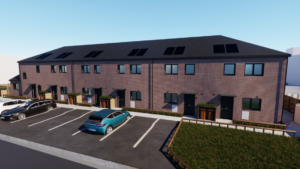Can senior cohousing solve the strains around health and social care?

Older Women’s Co-housing (OWCH), North London.
The UK’s population is rapidly ageing, and with people enjoying their lives longer than ever before, the need for age-appropriate housing has never been greater.
As the country’s health and social care systems face the twin strains of austerity and ever-growing demand, older people are starting to look at alternative ways of living together, away from the isolation of sheltered housing or overly rigid residential homes.
One of the most successful examples of alternative housing for older people is Older Women’s Co-housing (OWCH), the UK’s first senior cohousing community. It is made up of 26 women aged from their early 50s up to their 80s, all living in the same housing development in North London.
This cohousing development, designed to encourage mutual support and care between residents, is an example of what is known as ‘ageing in place’ – people living in their own homes as long as they are able to.
But what makes OWCH such a successful model and what lessons can be learnt from it? NewStart spoke with some of the people behind Older Women’s Cohousing to find out more.
‘A lot of sense’
Maria Brenton is a non-resident member of OWCH. Senior Cohousing Ambassador for the UK Cohousing Network, she is one of the architects behind OWCH’s creation.
OWCH came into being after Brenton completed research for the Joseph Roundtree Foundation in the 1990s on senior cohousing in the Netherlands, where the concept was already well established.
Brenton’s research found that this neighbourly form of housing kept older people more active, engaged, happy and healthy as they age – a stark contrast with the UK’s existing model of care.
‘The model that is dominant in the UK is a very top-down, kind of patronising model which tends to do things to older people for older people – it infantilises them and is basically ageist,’ Brenton said.
‘It encourages them to be passive recipients rather than active agents and doesn’t enhance their sense of autonomy over their own lives at all.’
Brenton presented her research to a group of older women and they decided to try to create their own older women’s cohousing community in London.
Getting it off the ground was a laborious process taking almost 20 years, as support for cohousing in the UK remained scant and Barnet Council – in whose borough where the group were looking to buy a property – were initially resistant.
However, the project finally came together at the end of 2016, when OWCH finally moved into the building they had helped design.
The New Ground building in High Barnet, in which OWCH now resides, contains a mixture of 25 one-bed, two-bed and three-bed private flats, with 17 owned by members of OWCH and 8 socially rented by tenants of the housing association Housing for Women.
OWCH has been created as an intentional community, with potential residents needing to undergo an interview process. The women take decisions over the building themselves, share a communal space and gardens, and eat together at least once a month.
With an elected management committee and a series of work teams tasked with overseeing aspects of OWCH from gardening and housework to communications and finances, each member of OWCH shares responsibility for its upkeep, a fact that Brenton admits may not be to many people’s liking.
However, Brenton stresses that OWCH’s emphasis on shared responsibility and community is not only good for the residents’ physical health, but a crucial way of tackling the growing epidemic of loneliness among older people.
‘Services themselves have been cut to the bone and older people are marooned in their houses,’ Brenton said.
‘The more depressed they get, the more isolated, the less able they are to reach out to other people, so cohousing for those who like the idea makes a hell of a lot of sense.’
‘Liberating’
Jude Tisdall is one of OWCH’s 26 residents and was one of the last residents to become involved with the development.
She heard about OWCH through a friend, and after knowing she wanted to live in a different way as she got older, applied to move into the new building when a vacancy emerged.
Despite the site still being under construction, she made the snap decision to sell her flat and join OWCH, staying with friends before moving in with the group at the end of 2016.
While Tisdall admits that people close to her were bemused at first, two and a half years on she is able to justify her decision.
‘Managing it is difficult, but then the other side of that is that you have complete control,’ Tisdall said of OWCH.
‘It’s liberating to make decisions about not just the flat you live in or the house you live in but the environment you live in.’
Tisdall has embraced becoming a member of the OWCH community, and currently acts as chair of its management committee.
Both Brenton and Tisdall are firm in their belief that OWCH is saving health and social care a fortune by keeping the women who live there engaged.
According to Tisdall, nobody in New Ground has a carer, even though a quarter of the women are in their 80s, and the development’s intergenerational nature makes it easier for the women to support each other.
While OWCH was designed specifically for older women, Tisdall said that the idea could work for any type of person as our perceptions of age change.
‘The idea of being old at 50 – it’s half a life, it’s not older, it’s different,’ Tisdall said. ‘People haven’t caught up with that kind of understanding.
‘Seeing people living in such a positive way right up until their 90s is inspirational. It really motivates you.’
‘There’s a lot of interest in it’
The example set by Older Women’s Cohousing is beginning to pay off, as policy-makers and planners are starting to pay attention.
Brenton now works with the Greater London Authority’s community-led housing support hub, and OWCH regularly hosts learning days from local authorities interested in trying out its model in their own communities.
‘We have to fend off visitors from OWCH almost every day of the week,’ Brenton said. ‘There’s a lot of interest in it.’
OWCH is already nurturing a group of around a dozen women under the age of 70 to potentially move into the development when the time is right.
Brenton and Tisdall are optimistic about the idea OWCH proposes for the future of older people’s housing: one where they have an active stake in how they choose to spend their later lives.
‘What I keep urging providers of housing for older people to do is do what they do differently and basically start with the people who are going to live there, and set up some sort of working partnership with them right from the beginning,’ Brenton concluded.
‘Being involved in that way is what really helped OWCH really strengthen its bonds as a community and keep that spirit alive that they’re living by now.’















